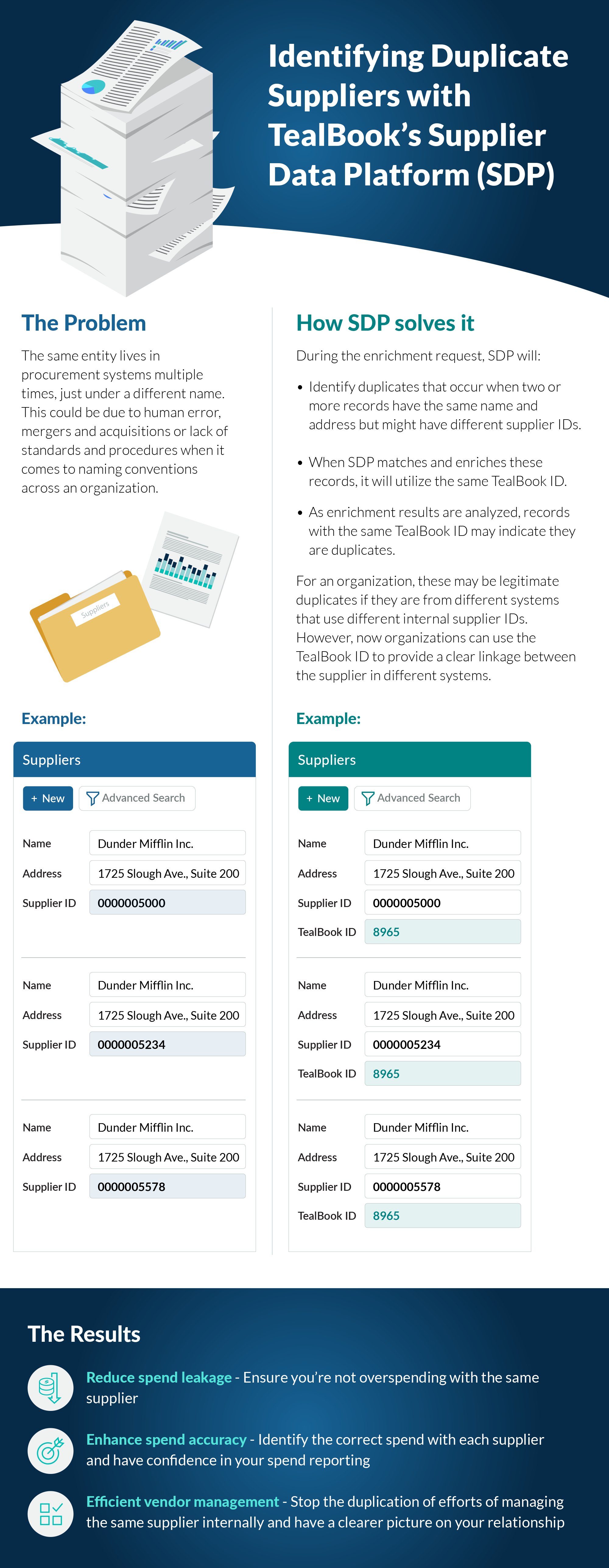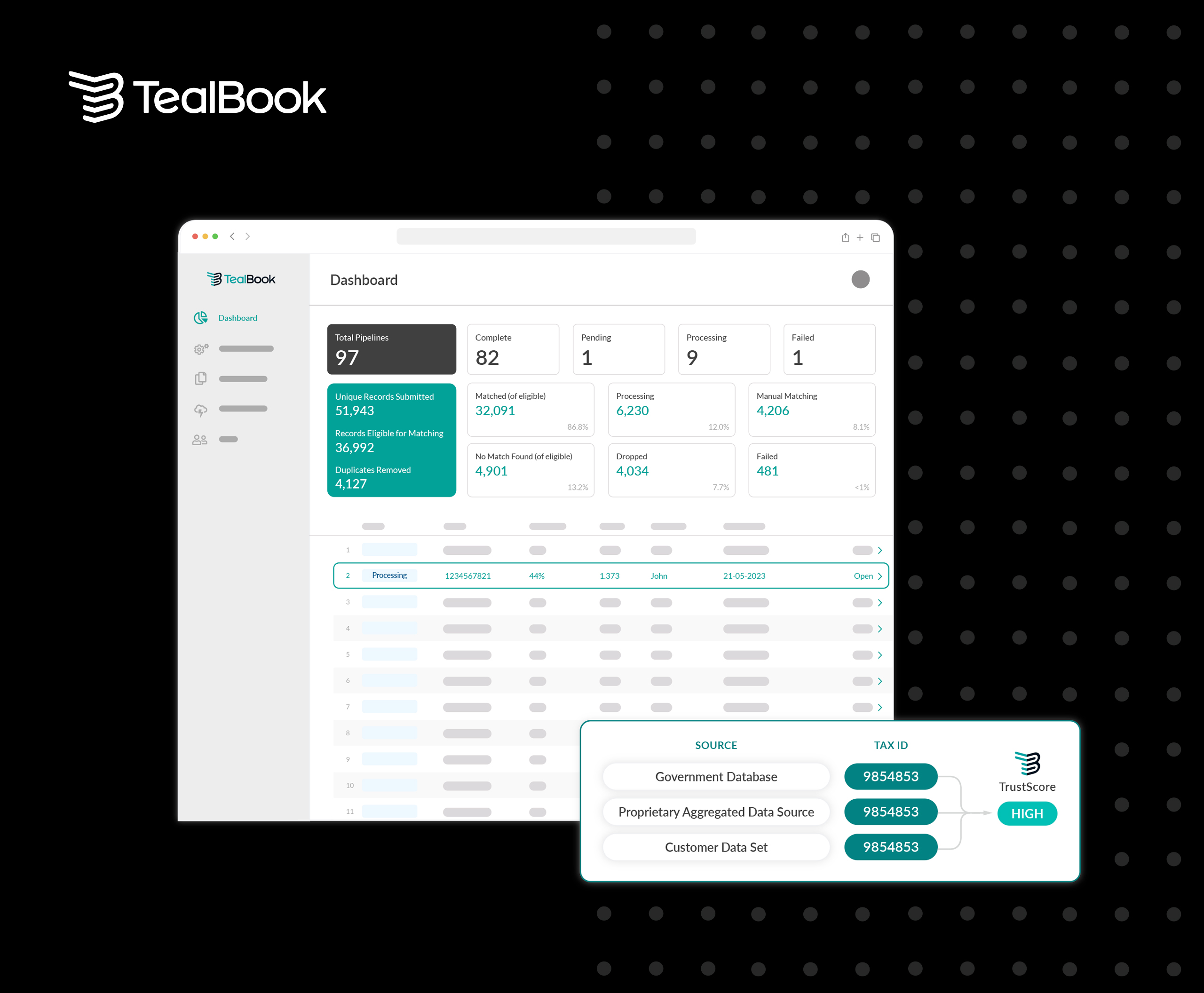In the procurement world, whether it’s accelerating supplier sourcing and onboarding, informing negotiations, meeting compliance requirements, or paying suppliers, data is the bedrock for everything.
The problem is, procurement teams are often trying to accomplish these tasks with inaccurate, incomplete, or outdated supplier data, which can lead to a cascade of issues – from increased spend, to missed payments. And in the age of digital transformation, unreliable data holds back the ability to scale procurement operational efficiency with technology like process automation and AI.
And, although there are a variety of niche solutions that have entered the procurement sphere, there hasn’t been a complete solution that collects the data, validates its accuracy, and routes it to the right systems across an entire organization. Until a supplier data foundation like TealBook’s Supplier Data Platform (SDP).
The power of a supplier data foundation: Your single source of truth
A supplier data foundation is a centralized data platform that continuously enriches supplier data, enabling organizations to streamline analytics, mitigate non-compliance and fraud risks, increase efficiency of your people and processes, improve spend analysis, and ensure smooth workflows at every stage of procurement. It eliminates the need for manual data management efforts that lead to errors and rework and automates the collection, verification, and enrichment of supplier data.
An organization’s single source of truth for all supplier-related information, TealBook’s Supplier Data Platform provides a single complete supplier profile that includes business-critical information, such as attributes and certifications. It integrates seamlessly with existing technology, whether it is an ERP, a Source to Settle tool, or a supplier onboarding system, to deliver confidence in the organization’s data integrity and consistency.
Data that can be trusted
SDP makes it easier for organizations to trust the data in their procurement systems and tools, which is critical for the 82% of procurement and sourcing executives who are less than confident that their supplier data is accurate.
Here’s how it works:
- Using the TrustScore feature, each attribute is assigned a rating from Very Low to Very High based on a consensus formula
- Organizations can decide what their comfort level is and ingest the data into their data lake, procurement systems, or applications on a case-by-case basis
- For example, an organization might choose to ingest the data for addresses with a ‘Medium’ rating but only take on Tax IDs that are considered ‘High’
Advantages of a supplier data foundation
With more confidence in their supplier data and less time spent on manual efforts, procurement organizations can start to take a customer and supplier-first approach with the benefits that supplier data foundations like SDP provide, such as:
- Data enrichment: Instead of allocating full-time resources to cleanse data and enter it manually into the organization’s systems, the most skilled employees can shift from manual supplier data management to strategic business opportunities because supplier data is refreshed and enriched when needed.
- Data deduplication: When the CEO asks about the procurement team’s spending with Company XYZ, they check the report and find 38 instances of the same supplier. SDP can flag duplicate supplier instances, helping with better financial decision-making, ensuring organizations have accurate and up-to-date supplier data, giving real-time insights into their spending and business relationships.
- Improved data-driven processes: 80% of companies that undergo a successful digital transformation have access to quality data. The problem is, 55% of companies still struggle with leveraging their data1. SDP routes data to an organization’s existing tools and applications, so everyone can be working from the same playbook and see data as an opportunity instead of a headache.
- Spend consolidation: With accurate data, organizations can uncover cost savings. For example, an organization might have 12 spend instances with the same vendor. With SDP, it can be paired down, allowing organizations to have better negotiating power and economies of scale.
- Financial loss reduction: The quality supplier data provided by SDP not only helps avoid late payments to vendors, it also prevents erroneous payments and saves the resources used for audit recovery to remediate the lost money.
The Supplier Data Platform in action
Now let’s unpack SDP through the lens of solving a typical issue that many organizations face: identifying duplicate suppliers. Sometimes, the same entity can exist multiple times in an organization’s system. This duplication can happen due to human error, unconsolidated mergers and acquisitions, or even oversight in identifying and fixing the problem. The problem cascades throughout the organization and can lead to spend leakage, inaccurate spend analysis and incorrect information to properly manage the supplier.

What about when supplier names and addresses are inconsistent? It’s a problem that organizations deal with regularly.
Suppliers often exist in multiple systems, such as:
- Enterprise resource planning tools (ERPs)
- Sourcing tools
- Analytics applications
- Risk tools
Supplier records might end up duplicated, because of acquisitions, divisions, or other business factors. However, linking the same supplier across different systems becomes challenging when names or addresses lack consistency.
For instance, a supplier may be referred to as “ABC” in one system and “Apple Banana Company” in another. Similarly, an address might be listed as “95 4th St NYC, USA” in one system and “95 Fourth Street New York, United States of America” in another. While humans can identify these similarities, software tools struggle with identifying these potential mismatches on a large scale. As a result, simple rollups of spend analysis could yield significant inaccuracies.
To ensure accurate analysis, it’s crucial to address these discrepancies and develop robust solutions that can handle the complexities of supplier data across various systems.
The impact of trusted data
Once an organization has trusted data throughout, master data management becomes second nature and leads to promising change throughout the procurement function and beyond.
- Advance procurement’s priorities that rely on high quality data (save time, reduce costs, ensure supply).
- Optimize the significant investments in software technologies that depend on quality data to deliver on promised ROI.
- Reduce costs associated with third-party providers of data and recurring data cleansing and classification service fees.
- Avoid costly implementation and upkeep of internal data infrastructure required to deliver high quality supplier data across growing requirements.
Embracing the Future
As the procurement function continues to evolve, the organizations who succeed will embrace change. The status quo of a supplier data foundation shouldn’t just be viewed as another tool to add to your tech stack. Instead, it should be viewed as a valuable part of your digitization strategy as it ensures the integrity and reliability of your supplier data and proliferates trusted data throughout your organization, driving efficiency, accuracy, and informed decision-making.
Sources
1PwC Global Digital Procurement Survey – 4th edition, 2022


